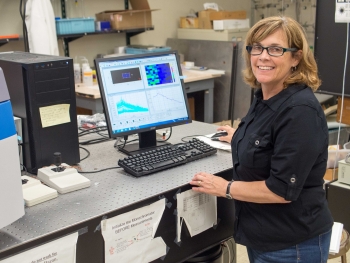
School:
Grade Level:
Teaching Position:
Supervisor:
Department:
Mentor:
Research Project Year:
Research Project Title:
Research Project Description:
Accurate diagnosis of disease is dependent on precise detection of biomolecules. Surface Enhanced Ramen Spectroscopy (SERS) can be used as a specific and sensitive method for biomolecule recognition via gold nanoparticles (AuNPs). This investigation analyzed the protocols for the assembly of the AuNPs and the substrate using Tumor Necrosis Factor Alpha as a target biomolecule. The three day procedure for the AuNPs reduces the aggregation of the particles and assists in the attachment of the DNA in correct alignment. The first investigation posed the idea that it may be possible to eliminate the first day of protocol. UV Vis and qubit were used to quantify the ratio of DNA strands per AuNP and the data indicates that eliminating the first day does not greatly affect the ratio. The second investigation studied passivating agents which are used to prevent nonspecific binding of the AuNP to the substrate which can lead to a false positive diagnosis. Ellman’s reagent, also known as DTNB (5, 5-dithio-bis-2-nitrobenzoic acid) is frequently used in research as a passivating agent. The investigation examined MUTEG (11-mercaptoundecy tetra ethylene glycol) in different ratios to the concentration of DTNB and a 10:1 ratio indicated the most promise.
Curriculum Project Year:
Curriculum Project Title:
Curriculum Project Description:
The goal of this project was to improve students ability to make connections between reduction-oxidation (redox) chemistry involved in single displacement reactions, in electrochemistry and real world applications of redox reactions. Most high school chemistry textbooks suggest these topics be covered in different semesters, although they all involve the process of electrons being lost and gained through a chemical reaction. My RET 1 experience involved a redox reaction involving gold nanoparticles, as I was developing curriculum for RET 2 I decided to create a unit to teach these topics consecutively. This unit has been sequenced to provide a scaffolding of student knowledge to support understanding in preparation for the culminating engineering activity, building a microscale battery. Typical chemistry course focuses on the symbolic level of thinking, in discovering the relationships of this project students will also engage in macroscopic, submicroscopic and symbolic activities through real world applications. Identifying and connecting the 3 levels is neither obvious nor automatic for students.
